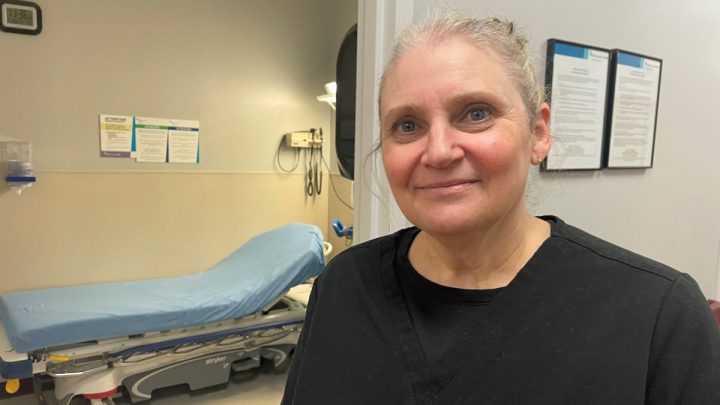
America’s rural hospitals are in the red

Battle-tested nurse practitioner Peni Russell is among the few health care workers responsible for each and every trauma, illness or ailment that comes through the emergency room doors at St. Luke’s Health – Memorial San Augustine — a rural, one-story hospital in East Texas.
An emergency tracheotomy. Delivering a 27-week-old preemie. The aftermath of an oil rig explosion or wood chip mill accident. It’s on her.
“It is stressful in the middle of the night when there’s four people in the whole hospital and your radiology tech is trying to perform their job and you have five or seven patients,” Russell said.
Emergency room and outpatient services like radiology and physical therapy are what’s left of this rural hospital in the 2,000-person town of San Augustine. The hospital, like many others across the country, has been hemorrhaging money and faces financial uncertainty ahead.
It recently stopped offering inpatient services and cut 17 positions, which was roughly a third of its staff. The move was not without cause though; on any given day, the hospital had an average of one patient, according to Monte Bostwick, president of St. Luke’s Health, East Texas Market. Despite the small patient volume, he said overall hospital operating expenses increased by around 8%.
“When you’re already operating at a deficit, if you see your operating expenses going up, but there’s no more money coming in, then let’s see what else we can do,” Bostwick said.
What the hospital did was cut its inpatient staff and maintain federal financial aid through a new government program that provides funding to designated Rural Emergency Hospitals.
The hospital in San Augustine had already been receiving government cash as a Critical Access Hospital, which required them to maintain inpatient beds. The new designation allowed the hospital to eliminate inpatient care, which cuts down on staffing costs, and keep their federal funding.
But Bostwick said it won’t be enough to turn a profit. “We still anticipate operating at a negative deficit.”
Bostwick and others are trying to avoid the fate of the 76 rural hospitals that have closed nationwide since 2010. Though these hospitals staved off closures during the pandemic thanks to an influx of government aid and an uptick in hospitalized patients that temporarily improved rural hospital finances, operating margins have since decreased substantially, according to health policy nonprofit KFF. And in states like Texas, which haven’t expanded Medicaid, the outlook is worse.

“I think you’re going to see closures continue,” said John Budd of ECG Management Consultants.
He said staffing shortages and the rising cost of labor is one pressure point among many for rural hospitals, since fewer physicians and nurses are willing to work in a remote area without the amenities of a bigger city.
“You’re now drawing from a much smaller recruiting pool in an environment where it’s already a shortage scenario,” Budd said.
He added that in some rural areas, patients can be sicker as well, as many work industrial jobs, have a lower income and may not have the same access to healthy food.
“We do like our butter and our fried food and our salts,” said St. Luke’s director of patient services Ashley London, who sees many patients with diabetes, high blood pressure and high cholesterol.
“It may be a decision between purchasing their diabetic medication and their hypertensive medications at the same time,” London said, “so we wind up seeing them pretty frequently here to control their diabetes because that medication is so expensive.”
Among those most invested in keeping St. Luke’s in San Augustine open is the community’s aging population, including many who are retired or elderly.
Long-time resident Wesley Hoyt has relied on this hospital since he was in high school in the 1960s.
“I had an accident up here at the fieldhouse. One of those huge circular fans struck me in the head,” he said. “They brought me here to this hospital.”
Again, just a few years back, Hoyt experienced another crisis: a stroke.

“When I started to get dressed. I noticed that my left side suddenly just went numb,” he said.
He got a ride to the hospital, and “within 10 to 15 minutes, they had run me into a CT scan,” he said.
Because of the scan, they were able to give him a treatment to minimize the effects of the stroke. They gave it to him before he was flown to the veteran’s hospital in Houston. Without that treatment, he believes he might have ended up paralyzed.
“I truly would not be here today but for the fact that this hospital exists and has the wonderful folks that that work up here,” Hoyt said. “They literally saved my life.”
There’s a lot happening in the world. Through it all, Marketplace is here for you.
You rely on Marketplace to break down the world’s events and tell you how it affects you in a fact-based, approachable way. We rely on your financial support to keep making that possible.
Your donation today powers the independent journalism that you rely on. For just $5/month, you can help sustain Marketplace so we can keep reporting on the things that matter to you.











